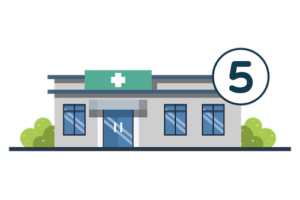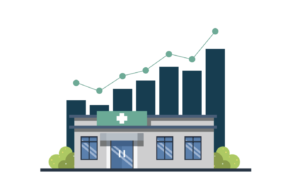Supporting Smooth FQHC Patient Volume with Digital Solutions
For Federally Qualified Health Centers (FQHCs), the ability to do more with the same or less has become an artform. These facilities rely on government funding to help them serve the healthcare needs of everyone from highly populated urban neighborhoods to underserved rural communities – it’s a financial dependency that leaves FQHCs constantly struggling to find ways to deliver quality care day in and day out, regardless of the resources at their disposal.
The challenge has only grown more intense in this time of COVID-19. In-office patient visits are climbing back towards pre-pandemic levels, and telehealth visits have increased 38X. Staff burnout is more prevalent than ever. And finding and hiring qualified personnel continues to be a problem, if the budget to hire is even available. To relieve the pressure and gain the necessary scalability to adapt as patient volumes fluctuate, FQHCs are focusing on digital transformation and building or enhancing a digital front door that automates, yet optimizes patient engagement and drives greater efficiency through their organizations.
Establishing a true digital front door is one of the top business priorities among the FQHC community. The digital front door simplifies the patient experience and enables facilities to give patients round-the-clock access to the practice – patients can schedule appointments, choose a provider, pre-register, check-in or even submit payment at their convenience. By offering this level of access, FQHCs improve the patient experience, while reducing the overall burden on practice staff and safeguarding themselves against resource constraints, even as patient volume increases.
Access Anytime, Anywhere
Patient check-in is an area especially ripe for transformation within FQHCs, and it’s one where the benefits can be felt immediately. 97% of Americans have access to cell phones or mobile devices – up from 35% just 10 years ago – which gives the vast majority of patients across demographic groups the power to engage with a healthcare facility from virtually anywhere. If the facility is using a solution like Clearwave Patient Check-in, those patients can use their smartphones to schedule their appointments and to check in – they can enter or update their profile information, provide information regarding symptoms or the purpose of their visit and even add insurance or payment details before they ever step foot through the door. This significantly reduces staff workloads, as patients can now bypass the front desk and go directly to the waiting room or log in to their telehealth appointment without requiring assistance. The result is that patients enjoy the convenience and simplicity of a self-service model, while practices avoid overloading and burning out their staff – both of which lead to an optimal experience for all.
Reporting Made Simple
Among the many areas in healthcare hit hard by COVID-19 have been the processing and distribution of relief funds – or any federal funding, for that matter. For FQHCs, such delays have had a major impact on cash flow, forcing them to stretch the resources they have, while trying to rush paperwork submissions and follow up on outstanding filings. Technology like the Clearwave Patient Engagement Platform can simplify this process by helping facilities automate and expedite the collection, synchronization and reporting of data with the utmost accuracy. So, while they can’t control the speed with which the government acts or responds, FQHCs can rest assured that they have the ability to pull data, generate reports and submit for their funds fast – without any manual clerical errors that typically lead to submissions being kicked back or rejected altogether.
Maximizing Throughput
Helping to expedite the speed and accuracy of fund submissions isn’t the only way digital solutions are helping FQHCs boost cash flow. They’re also enabling adjustments that have more immediate impact. For example, with Clearwave Scheduling, practices can optimize every appointment slot in their daily schedules and treat more patients in a given day with the same quality of care. Clearwave technology also provides automated insurance eligibility verification, ensuring all insurance information is current and flagging potential coverage issues in advance. This frees the front-desk staff to focus on higher-touch patient-support matters, while reducing the number of claim rejections, which has been especially important to FQHCs during the pandemic, with disruptions to patients’ healthcare coverage due to job losses or career changes.
Communities everywhere depend on FQHCs to deliver high-quality healthcare and provide the best possible patient experience. By adopting the right technologies and a well-thought-out digital transformation strategy, these essential facilities will be poised to do exactly that, regardless of any uncertainty or fluctuations brought on by external conditions. For more information, download the eBook, “A Look Ahead the Top Six Trends Impacting FQHCs in 2021.”
Recommended for you
Related Posts
Promoting Patient Participation in Clinical Trials
Reading Time: 4 minutes There are roughly 74,000 registered clinical trials currently underway in the US to help aid advancements in medicine. However, only…
Why FQHCs Need to focus on Patient Engagement Solutions
Reading Time: 4 minutes Updated, March 23, 2023, by Blakely Roth It’s never been more important to focus on providing a stable and accessible…
Why Appointment Reminders Need to Be More Than a Postcard in the Mail
Reading Time: 2 minutes In the past, many practices depended heavily on sending out postcard reminders, but they are no longer as effective as…




